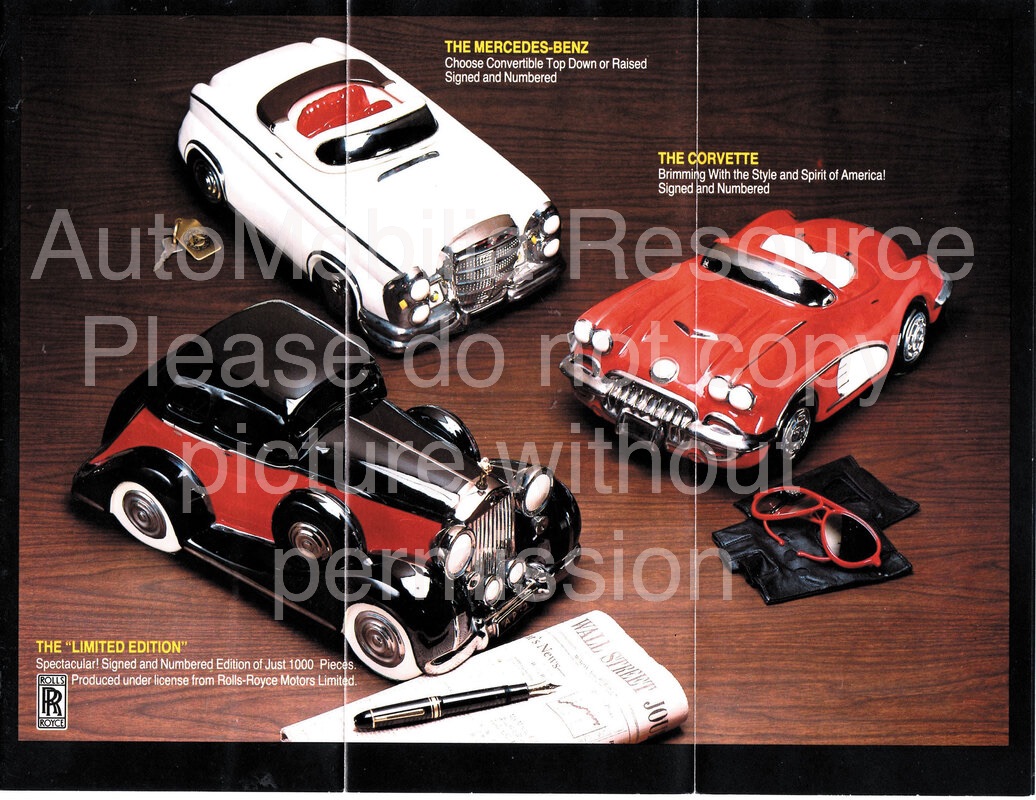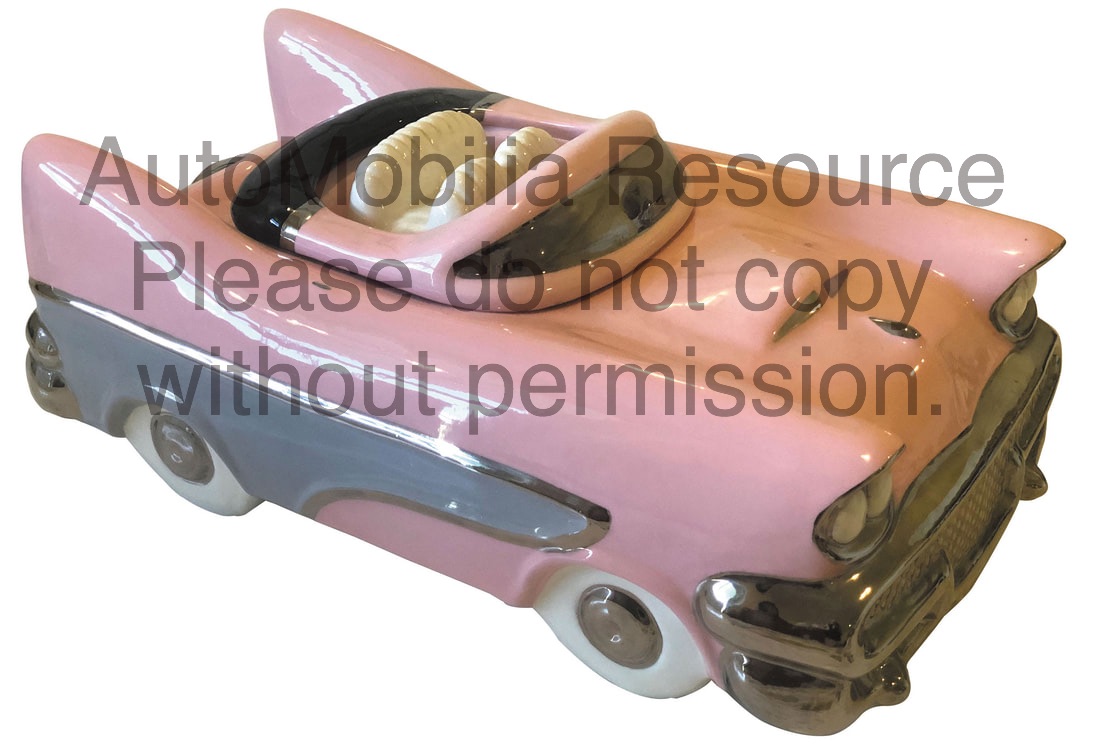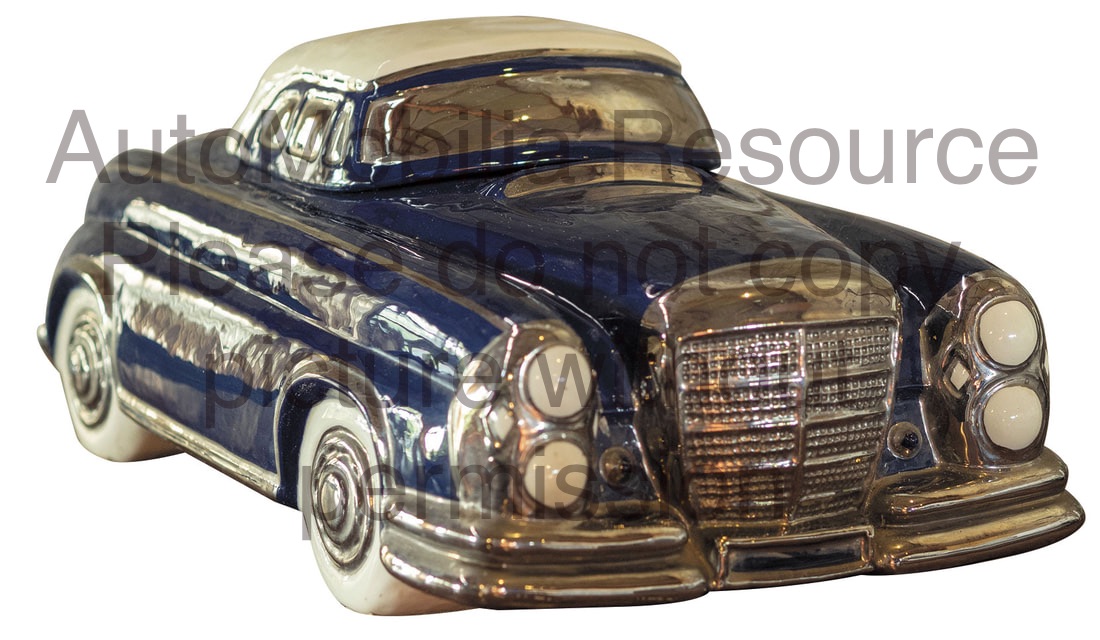|
Nov/Dec 2020 edition Issue #13, AutoMobilia Resource Magazine Ken Gross Appleman Ceramic Cookie Jars: |
| Most of the Appleman cookie jars that I’ve ever seen, including four of the five examples I own, are signed and dated in Sharpie-type ink with the signature, “Appleman,” on the unpainted bottom. Examples of these artsy jars were owned by notables like Andy Warhol, Sofia Loren, Sylvester Stallone, Dustin Hoffman, Reggie Jackson, Dolly Parton and Bill Cosby. They were spotted in photographs when celebrity photographers performed shoots of their famous subjects’ homes for magazines. |
For years, I wanted to know more about these cute ceramic novelties, so after I read the AutoMobilia Resource article on Sadler OKT42 teapots in issue #12, I told Editor Marshall Buck I’d like to research the Appleman items for an article. I only knew what you’ve just read. But I wanted to know much more.
Publisher Sharon Spurlin suggested we run an ad in their classifieds, along with a photo of “Sid’s Radio Taxi,” to see if a reader could help us with more information. We struck gold on the first day when I received a call from Stephen Ring, who’d ordered a limited-production Jaguar cookie jar from Glenn Appleman (more about this in part II, issue 14 of AutoMobilia Resource).
Stephen said he thought Glenn lived in Brooklyn, and he believed he hadn’t been making the cookie jars for decades. He didn’t have Glenn’s phone number, but through the magic of the Internet, I was soon speaking with the elusive Mr. Appleman.
Friendly, enthusiastic and blessed with a great memory, Glenn Appleman was only too happy to tell me all about his short-lived career as a cookie jar magnate.

“I didn’t initially make these pieces as cookie jars.” Appleman explains. “I called them objets d’art. But people thought of them as cookie jars. Who was I to argue?”
“Besides, cookie jars became a hot collectable after Andy Warhol died and his collection of 175 jars was auctioned off by Sotheby’s in 1987. They brought over $250,000. People thought if Andy Warhol was collecting cookie jars, they must be art.”
| “That first car, the Sid’s Taxi, was known and marketed as the “Humperbump.” The next car out was the Packard, in 1979. Then I thought it would be cool if I made a convertible out of it. So, the Packard had two different lids and it also became a police car. In 1980, I made the first Buick – a 1952 model with a big grille that looked like a Viking battering ram. In 1981, things were slow. I didn’t have enough money to make a new car, so I came out with a Buick convertible by designing a different top. And I offered them in different colors.” |
“In late 1981, I did the DeSoto convertible, which was actually called the Phantazoom. I thought it would be a great idea to use the crazy two-tone colors of the 1950s, so I could make pink cars and purple cars. I moved out to New Jersey in 1982, and the first car there was the limited-edition Rolls-Royce. I recently saw one on eBay with an intact hood ornament, which amazes me. They weren’t really designed for the long haul.”
“And that was it. Two years later, we went out of business.”
| “I was fortunate enough to pick up the beginning of the wave of the crafts movement in America. There were craft galleries and books. Art collectors were starting to acknowledge American crafters as artists. And there were many craft shows. The Rhinebeck show was the most famous, and there was one in Baltimore. The American Craft Council (ACC) still exists. They managed the shows. Dealers would order, and you went home and made stuff. We had a few department store orders, from I. Magnin & Company, and Marshall Field.” |
“I looked at the crystal ball and realized, we’re not growing, we’re shrinking, and I said, ‘I’ve been doing it for ten years, and I’m tired. I think I’ll do something else.’ I went back to college and I have been a computer programmer ever since.”
| The business initially seemed successful, so I asked Glenn if there were other reasons that contributed to its demise. We’ll learn about Glenn’s famous clientele and preview a future Appleman design next issue, in AutoMobilia Resource #14. Ken Gross |
from Appleman Cookie Jar expert Ken Gross...
Subscribe to AutoMobilia Resource
Hi Ken,
I live in Connecticut and have a fine collection of 16 of Glenn’s cars. If you need any photos of rarer color combinations, I’d be glad to email some to you for your next installment. Great article. Thanks!
Brent
Hi Ken - great article. I have a collection of 14 Glenn Appleman cars and beer trucks. Unfortunately, during a move one of the lids for a beer truck was lost. Would love to find one - if any of your readers/collectors happen to have one available I would be happy for the connection.
Thanks
Jim
James Davis, if you subscribe to AutoMobilia Resource, you get a free classified ad, and that sounds like a great thing to advertise for. Give us a call at 954-579-5280 or hit the subscribe button at the top of the page to find out how. Sharon Spurlin, Publisher
Loved reading Glenn Appleman's bio and the lifecycle of his artistic & fun creation.
I own a Black/Red DeSoto "Phantazoom". I first saw it in a gift shop of a Houston hotel around 1982 totally unaware of its creator. I remember balking on purchasing it because of its cost, but it haunted me. When a colleague from our Houston branch was coming months later for a conference, I asked her to pick it up for me and I'd reimburse her. She did. Fast forward 40 yrs later, I still have it!
Leave a Reply.
Ken Gross
Ken Gross has written over 15 books and numerous articles for automotive magazines. He collects Sadler OKT42 teapots, Glenn Appleman cookie jars and Ford flathead speed equipment.
[email protected]












 RSS Feed
RSS Feed